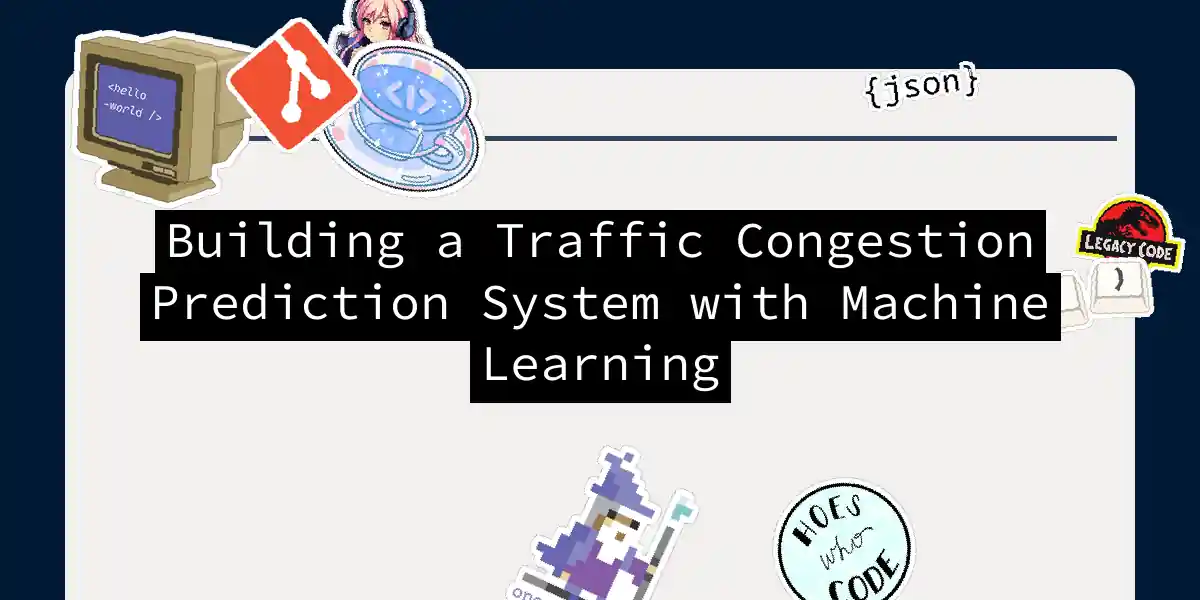The Never-Ending Battle with Traffic: How Machine Learning Can Save the Day
If you’ve ever found yourself stuck in a sea of brake lights, wondering why the road seems to have turned into a parking lot, you’re not alone. Traffic congestion is a universal problem that plagues cities around the world, wasting time, fuel, and our collective sanity. But what if I told you there’s a way to predict and even mitigate this chaos using machine learning? Let’s dive into how we can build a system to forecast traffic congestion and make our daily commutes a bit more bearable.
Why Machine Learning?
Machine learning is the perfect tool for tackling traffic prediction because it can handle the complexity and variability of traffic data. Unlike traditional statistical methods, machine learning algorithms can process vast amounts of data, including traffic flow, vehicle speed, traffic density, weather conditions, road conditions, and even social media updates about traffic.
Data Collection and Preprocessing
Before we can start predicting traffic, we need data. Lots of it. Here are some common sources of traffic data:
- Traffic Sensors: These can provide real-time data on traffic flow and density.
- GPS Data: Vehicles equipped with GPS can send real-time updates on their location and speed.
- Traffic Cameras: These can provide visual data on traffic conditions.
- Social Media: Tweets and posts about traffic can offer valuable insights.
Once we have our data, we need to preprocess it. Here’s a step-by-step guide:
Importing Libraries
import pandas as pd
import numpy as np
import matplotlib.pyplot as plt
from sklearn.model_selection import train_test_split
from sklearn.ensemble import RandomForestRegressor
from sklearn.metrics import mean_squared_error
Loading and Exploring the Data
# Load the dataset
data = pd.read_csv('traffic_data.csv')
# Explore the data
print(data.head())
print(data.info())
print(data.describe())
Feature Engineering
We need to create additional features that can help our model understand the data better. For example, we can extract the day of the week, hour of the day, and other time-related features.
data['DateTime'] = pd.to_datetime(data['DateTime'])
data['DayOfWeek'] = data['DateTime'].dt.dayofweek
data['HourOfDay'] = data['DateTime'].dt.hour
Handling Missing Values
data.fillna(data.mean(), inplace=True)
Choosing the Right Algorithm
There are several machine learning algorithms that can be used for traffic prediction, each with its own strengths and weaknesses.
Regression Models
Regression models, such as Linear Regression, Random Forest Regressor, and Gradient Boosting Regressor, are commonly used for traffic prediction. Here’s an example using a Random Forest Regressor:
# Split the data into training and testing sets
X = data.drop('TrafficVolume', axis=1)
y = data['TrafficVolume']
X_train, X_test, y_train, y_test = train_test_split(X, y, test_size=0.2, random_state=42)
# Train the model
model = RandomForestRegressor(n_estimators=100, random_state=42)
model.fit(X_train, y_train)
# Make predictions and evaluate the model
y_pred = model.predict(X_test)
print(f'Mean Squared Error: {mean_squared_error(y_test, y_pred)}')
Deep Learning Models
For more complex patterns, deep learning models like Recurrent Neural Networks (RNNs), Long Short-Term Memory (LSTM) networks, and Convolutional Neural Networks (CNNs) can be very effective.
from keras.models import Sequential
from keras.layers import LSTM, Dense
# Prepare the data for LSTM
X = data.drop('TrafficVolume', axis=1)
y = data['TrafficVolume']
X = X.values.reshape(-1, 1, X.shape)
# Build the LSTM model
model = Sequential()
model.add(LSTM(50, input_shape=(X.shape, X.shape)))
model.add(Dense(1))
model.compile(loss='mean_squared_error', optimizer='adam')
# Train the model
model.fit(X_train, y_train, epochs=50, batch_size=32, validation_data=(X_test, y_test))
A Two-Level Machine Learning Approach
For a more robust prediction system, we can use a two-level machine learning approach as proposed in some studies. Here’s how it works:
Unsupervised Clustering: Use clustering techniques to group roads with similar traffic patterns.
from sklearn.cluster import KMeans # Perform clustering kmeans = KMeans(n_clusters=4) kmeans.fit(X) labels = kmeans.labels_Supervised Models: Train separate supervised models for each cluster to predict traffic flow.
# Train a model for each cluster for cluster in np.unique(labels): cluster_data = X[labels == cluster] cluster_y = y[labels == cluster] model = RandomForestRegressor(n_estimators=100, random_state=42) model.fit(cluster_data, cluster_y) # Use the model to predict traffic flow for roads in this cluster
Visualizing the Workflow
Here’s a flowchart to illustrate the workflow of our traffic prediction system:
Challenges and Future Directions
While machine learning offers a powerful solution for traffic prediction, there are challenges to consider:
- Data Quality: The accuracy of predictions depends heavily on the quality of the data. Missing or erroneous data can significantly impact the model’s performance.
- Complexity: Machine learning algorithms can be complex and difficult to interpret, making it challenging to identify the factors driving the predictions.
- Real-Time Processing: For real-time traffic prediction, the system needs to process data quickly and efficiently.
Despite these challenges, the potential benefits of using machine learning for traffic prediction are significant. By continuously improving these systems and incorporating new data sources and algorithms, we can make our cities more efficient and our commutes less frustrating.
Conclusion
Traffic prediction using machine learning is not just a theoretical concept; it’s a practical solution that can be implemented to improve urban transportation systems. By leveraging historical data, real-time inputs, and advanced algorithms, we can build systems that predict traffic congestion with high accuracy. Whether you’re a software developer, a data scientist, or just someone tired of sitting in traffic, this technology has the potential to make a real difference in our daily lives. So next time you’re stuck in traffic, remember that there’s a way out – and it starts with machine learning.
